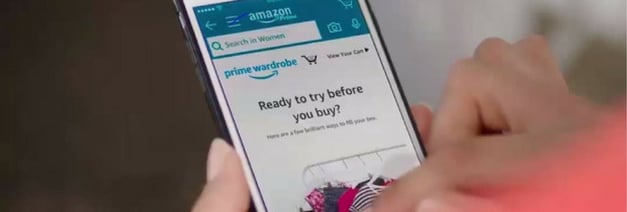
Amazon has made no secret of its ambitions to disrupt the apparel industry and it’s willing to take a very public test-and-learn approach to doing so. Amazon hit $13 billion in clothing and footwear sales in 2016—13% of its U.S. gross merchandise volume—and is taking aggressive action to grow that share in 2017. While they’ve shuttered their Style Code video platform, Amazon remains committed to fashion, with new efforts including launching eight value-oriented, basics-focused private label brands and the Amazon Echo Look, a video-enabled version of the Echo that snaps full length photos of users and employs Amazon’s team of Style Check consultants to offer wardrobe suggestions.
Inside Amazon's Prime Wardrobe
Amazon’s latest venture follows a similar “test and learn” approach, but this time, it’s the consumer who is “testing.” Prime Wardrobe, a service currently offered exclusively to Prime customers, follows the subscription box model. Prime Wardrobe allows consumers to select up to 15 clothing, shoe, and accessory items, which ship free to the consumer. Consumers have one week to decide which items they’d like to keep and return the rest postage paid. Unsurprisingly, consumers are incentivized to keep items with discounts; keep three or four items and receive a 10% discount or 20% for buying five or more items. Unlike subscription models, there’s no service fee or commitment—Prime members have the flexibility of choosing the clothing that they want as frequently as they’d like to receive it.
This approach may attract those consumers who may have been reluctant to take a chance on Amazon apparel offerings while simultaneously giving Amazon insight into trends, consumer behavior, and intelligence to personalize shoppers’ carts. It also removes barriers to online shopping that often plague online retailers: the ability to see, touch, and try on before committing to buy. Amazon’s proposition also solves for the consumer practice known as “bracketing,” where an estimated 40% of consumers buy multiple items with the intent to return at least some of them—Amazon invites consumers to do this, offering consumers the freedom to try as many items as they’d like. Further, with its acquisition of Whole Foods, Amazon could give consumers the option of returning boxes at any Whole Foods locations, driving traffic to stores, while offering convenience to the consumer.
Prime Wardrobe could substantially shake up the subscription apparel box model, but how will it ultimately impact retail remains to be seen. Emerging brands would have to produce enough stock to participate, premium fashion brands are still reluctant to partner with Amazon, and there’s no question that Amazon intends to give preference to its own brands. There’s also the question of returned products being instantly re-saleable and other logistical issues to consider. Finally, successful boxes like Stitch Fix offer data-driven serendipity—pieces are chosen for the consumer based on multiple data points, so the box offers educated surprises and the opportunity to break out of buying “what you always buy.” Look for Amazon to address that next.
As Amazon continues to disrupt industries and consumers increasingly discover and buy on the channel, marketers need to thoughtfully address the Amazon marketplace and take a strategic approach to optimizing their brand’s presence. Discover how to market a product on Amazon. Contact us to learn more about our expert Amazon optimization services.
Source: Retail Dive Amazon Prime Wardrobe Taps Into Stitch Fix’s Box Success, June 2017




COMMENTS